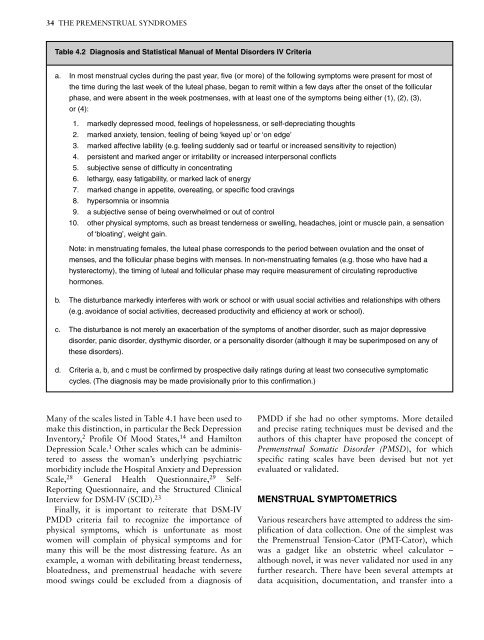Premenstrual Syndromes : PMS and PMDD - Rutuja :: The site ...
Premenstrual Syndromes : PMS and PMDD - Rutuja :: The site ...
Premenstrual Syndromes : PMS and PMDD - Rutuja :: The site ...
Create successful ePaper yourself
Turn your PDF publications into a flip-book with our unique Google optimized e-Paper software.
34 THE PREMENSTRUAL SYNDROMES<br />
Table 4.2 Diagnosis <strong>and</strong> Statistical Manual of Mental Disorders IV Criteria<br />
a. In most menstrual cycles during the past year, five (or more) of the following symptoms were present for most of<br />
the time during the last week of the luteal phase, began to remit within a few days after the onset of the follicular<br />
phase, <strong>and</strong> were absent in the week postmenses, with at least one of the symptoms being either (1), (2), (3),<br />
or (4):<br />
1. markedly depressed mood, feelings of hopelessness, or self-depreciating thoughts<br />
2. marked anxiety, tension, feeling of being ‘keyed up’ or ‘on edge’<br />
3. marked affective lability (e.g. feeling suddenly sad or tearful or increased sensitivity to rejection)<br />
4. persistent <strong>and</strong> marked anger or irritability or increased interpersonal conflicts<br />
5. subjective sense of difficulty in concentrating<br />
6. lethargy, easy fatigability, or marked lack of energy<br />
7. marked change in appetite, overeating, or specific food cravings<br />
8. hypersomnia or insomnia<br />
9. a subjective sense of being overwhelmed or out of control<br />
10. other physical symptoms, such as breast tenderness or swelling, headaches, joint or muscle pain, a sensation<br />
of ‘bloating’, weight gain.<br />
Note: in menstruating females, the luteal phase corresponds to the period between ovulation <strong>and</strong> the onset of<br />
menses, <strong>and</strong> the follicular phase begins with menses. In non-menstruating females (e.g. those who have had a<br />
hysterectomy), the timing of luteal <strong>and</strong> follicular phase may require measurement of circulating reproductive<br />
hormones.<br />
b. <strong>The</strong> disturbance markedly interferes with work or school or with usual social activities <strong>and</strong> relationships with others<br />
(e.g. avoidance of social activities, decreased productivity <strong>and</strong> efficiency at work or school).<br />
c. <strong>The</strong> disturbance is not merely an exacerbation of the symptoms of another disorder, such as major depressive<br />
disorder, panic disorder, dysthymic disorder, or a personality disorder (although it may be superimposed on any of<br />
these disorders).<br />
d. Criteria a, b, <strong>and</strong> c must be confirmed by prospective daily ratings during at least two consecutive symptomatic<br />
cycles. (<strong>The</strong> diagnosis may be made provisionally prior to this confirmation.)<br />
Many of the scales listed in Table 4.1 have been used to<br />
make this distinction, in particular the Beck Depression<br />
Inventory, 2 Profile Of Mood States, 14 <strong>and</strong> Hamilton<br />
Depression Scale. 1 Other scales which can be administered<br />
to assess the woman’s underlying psychiatric<br />
morbidity include the Hospital Anxiety <strong>and</strong> Depression<br />
Scale, 28 General Health Questionnaire, 29 Self-<br />
Reporting Questionnaire, <strong>and</strong> the Structured Clinical<br />
Interview for DSM-IV (SCID). 23<br />
Finally, it is important to reiterate that DSM-IV<br />
<strong>PMDD</strong> criteria fail to recognize the importance of<br />
physical symptoms, which is unfortunate as most<br />
women will complain of physical symptoms <strong>and</strong> for<br />
many this will be the most distressing feature. As an<br />
example, a woman with debilitating breast tenderness,<br />
bloatedness, <strong>and</strong> premenstrual headache with severe<br />
mood swings could be excluded from a diagnosis of<br />
<strong>PMDD</strong> if she had no other symptoms. More detailed<br />
<strong>and</strong> precise rating techniques must be devised <strong>and</strong> the<br />
authors of this chapter have proposed the concept of<br />
<strong>Premenstrual</strong> Somatic Disorder (<strong>PMS</strong>D), for which<br />
specific rating scales have been devised but not yet<br />
evaluated or validated.<br />
MENSTRUAL SYMPTOMETRICS<br />
Various researchers have attempted to address the simplification<br />
of data collection. One of the simplest was<br />
the <strong>Premenstrual</strong> Tension-Cator (PMT-Cator), which<br />
was a gadget like an obstetric wheel calculator –<br />
although novel, it was never validated nor used in any<br />
further research. <strong>The</strong>re have been several attempts at<br />
data acquisition, documentation, <strong>and</strong> transfer into a


